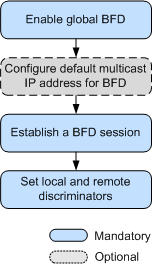Configuring Single-Hop BFD
Pre-configuration Tasks
Before configuring single-hop BFD, complete the following tasks:
Configure link layer protocol parameters for interfaces to ensure that the link layer protocol status on the interfaces is Up.
Configure an IP address for the Layer 3 interface.
Procedure
- Run system-view
The system view is displayed.
- Run bfd
BFD is enabled globally and the BFD view is displayed.
By default, BFD is disabled globally.
- (Optional) Run default-ip-address ip-address
The default multicast IP address for BFD is configured.
By default, BFD uses the multicast IP address 224.0.0.184.
If multiple BFD sessions exist on a path, for example, Layer 3 interfaces are connected through Layer 2 switching devices that support BFD, configure different default multicast IP addresses for the devices where different BFD sessions are established. In this manner, BFD packets can be correctly forwarded.
- Run quit
Return to the system view.
- Run the following commands as required.
Select proper parameters to create a BFD session based on IPv4 links.
On a Layer 3 interface that has an IP address configured, run bfd session-name bind peer-ip ip-address [ vpn-instance vpn-name ] interface interface-type interface-number [ source-ip ip-address ]
The binding information of the BFD session is configured.
By default, no BFD session is created.
When creating a single-hop BFD session for the first time, bind the single-hop BFD session to the peer IP address and the local address. To modify a configured BFD session, delete it and recreate a new one.

When the BFD configuration items are created, the system checks only the format of the IP address. The BFD session cannot be established if an incorrect peer IP address or source IP address is bound.
On a Layer 2 interface or a Layer 3 interface without an IP address, run bfd session-name bind peer-ip default-ip interface interface-type interface-number [ source-ip ip-address ]
The binding information of the BFD session is configured.
By default, no BFD session is created.

MAC address flapping still occurs even a multicast BFD session is created on the ring network where a loop prevention protocol is configured. This is because multicast BFD packets can be forwarded on the blocked interface.
- The BFD session that uses the default multicast IP address specified by default-ip-address cannot be established on the interface connected to a VPLS network in untagged mode on the S5720-HI, S5730-HI, S5731-H, S5731-S, S5731S-H, S5731S-S, S5732-H, S6720-HI, S6730-H, S6730S-H, S6730-S, and S6730S-S. In this case, use EFM to detect the link. For details about EFM and VPLS, see EFM Configuration and VPLS Configuration in the S2720, S5700, and S6700 V200R019C10 Configuration Guide - VPN respectively.
- If a multicast BFD session is bound to a Layer 3 interface to which the line protocol current state of the interface is Down, the status of the session is set to Down. You can run the unlimited-negotiate command to restart session negotiation. If the link is normal, the BFD session can go Up through negotiation.
Create a BFD session based on IPv6 links.
Run bfd session-name bind peer-ipv6 ipv6-address [ vpn-instance vpn-instance-name ] interface interface-type interface-number [ source-ipv6 ipv6-address ]
The binding information of the BFD6 session is configured.
When creating a single-hop BFD6 session for the first time, bind the single-hop BFD6 session to the peer IPv6 address and the local address. In addition, the configuration of the single-hop BFD6 session cannot be modified after the session is created.
When configuring the BFD6 session, the system checks only the format of the peer IPv6 address rather than its correctness. A BFD6 session cannot be established if an incorrect peer IPv6 address or source IPv6 address is bound.
- Run discriminator local discr-value
The local discriminator is set.
- Run discriminator remote discr-value
The remote discriminator is set.

The local discriminator of the local system must be the same as the remote discriminator of the remote system; the remote discriminator of the local system must be the same as the local discriminator of the remote system. Otherwise, BFD sessions cannot be established. After the local discriminator and the remote discriminator are configured, you cannot modify them.
If a BFD session is bound to the default multicast address, the local discriminator and the remote discriminator must be different.
- Run commit
The configuration is committed.
